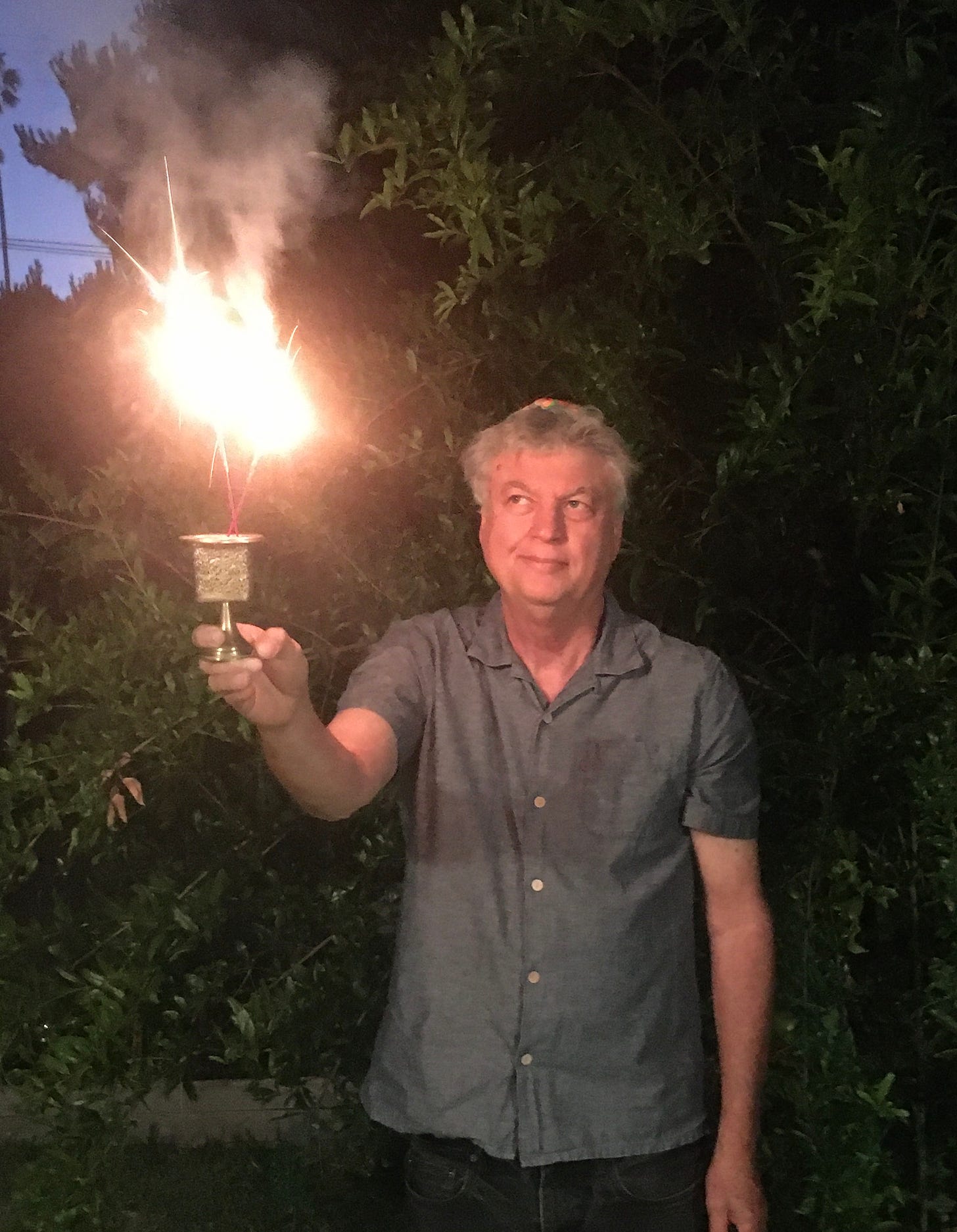
Folks,
At the end of this Star-Spangled Shabbat, which falls on the Fourth of July, our Havdalah candles may sparkle a little; even a lot. I thought I was confident and unafraid, that was until my "safe and sane" test candle flamed and crackled into life. Wow, talk about rockets’ red glare. Yet, in the afterglow of its exuberance, I was able to gather that after all we have been through these last few months, on this Shabbat, we are blessed with all manner of light, gladness and joy. Recent events in the streets, though throwing off sparks both damaging and illuminating, are showing us more thoughtful ways of how to think about each other. During the pandemic, even though our faces are often covered, a light still manages to show through, opening alternative strategies, many digitally-based, of staying in touch with family, friends and neighbors.
We may be locked down on this Fourth of July, but this issue of MegilLA is not, and I hope it helps you to discover and contemplate new ways of connecting the Jewish American experience to our great day of independence, and our long struggle for justice and freedom.
Shabbat shalom.
Edmon J. Rodman
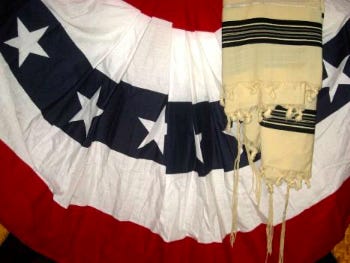
Jewish Stars and stripes
forever… at least for Shabbat
Edmon J. Rodman
Part “God Bless America,” and part challah-day, the Fourth of July comes to rest this year on Shabbat. In this time when we cannot gather for prayer or celebration, how can we find a way to observe both day of rest and independence?
If you believe in prayer, and even if you don’t, with the cases of coronavirus on the rise, and our collective sense of frustration with our government growing, now might be the time to get your blessings together in offering a prayer for our country and its leaders.
Don’t you think that Governor Newsom and Mayor Garcetti, leading us through a time of sickness, fear, economic crisis, and social upheaval; a time when our neighbors are literally dying to return to beach and bar, could use a prayer or two.
Why look to prayer now?
Jewish prayer can celebrate the renewal of life, and express gratitude, two qualities useful in a time when it is painful to listen to the news. Jewish prayers for our nation and its leaders can also speak to the banishment of hatred and bigotry, that life is sacred, and that our leadership be blessed with the insights of Torah.
In times when the ideals we have grown up with are being tested, a good prayer can keep our hearts and minds fixed on what values are important to us. Prayer can also channel the frustration we feel, and teach us, when needed, to ask for help from a source greater than ourselves.
For example, the “Prayer for our Country” (Find it Here) that is found in Siddur Sim Shalom published by the Rabbinical Assembly of the Conservative Movement, begins by asking for “Your blessings for our country, for its government, for its leaders and advisors, and for all who exercise just and rightful authority.”
“Teach them insights from Your Torah, that they may administer all affairs of state fairly,” the prayer continues.
Another version of the prayer, found in the Reform Movement’s prayer book “Mishkan T’filah,” asks God to “Grant our leaders wisdom and forbearance.”
When we pray for our nation, we also pray for ourselves. Recalling our long history of struggle for equality and justice in this country, tefilla, prayer, is a reminder to renew our efforts to make room in our lives for the equality and justice of others.
Says the Prayer for Our Country: “Bless the inhabitants of our country with Your Spirit. May citizens of all races and creeds forge a common bond in true harmony, to banish hatred and bigotry.”
Many Shabbat prayers ask us to remember our ancestors. Though referring to those names found in the Torah, we can use this day to remember our forebearers more immediate, and their journeys, often perilous, in coming to the land of opportunity, the U.S., what they called in Yiddish the goldene medina, “the golden country.”
As the sun sets, and three stars come out, we can also say Havdalah, a prayer which comes at the end of Shabbat, helping us draw distinctions between the sacred and the secular, between light and darkness. It is also a prayer of renewal, for the week, and on this Shabbat, for our country as well.
You can do it indoors, or out, alone or with a small group. (Havdalah Blessings Here) There is wine, and spices to revive the spirit. Traditionally, a multi-wicked candle is used (You can also hold two candles together), and its flame can be a reminder to let the glow of Shabbat light up the rest of your week. Especially on the Fourth, this can be your sparkler.

We were in on the boom, too
There is a fuse which connects those annoying and teeth-rattling firework booms, you are enduring every night and day, to Los Angeles Jewish history. Creating a boom of their own, as early as 1925, two Jewish businessmen were selling “Supercharged Flashlight Crackers,” around Southern California.
Pensick & Gordon, a Los Angeles toy wholesaler, founded in 1925, sold “Spirit of ‘76” firecrackers and a “Panther” brand which came in a 24 pack. Today, the labels are hard-to-find collector items.
In the 1940s, the company had their showroom in a downtown brick building at the corner of 3rd St. and Santa Fe. By the 1950s, they touted themselves as “The West’s Largest Exclusive Toy Wholesalers.” In 1952, one big seller for the toy distributor was “Tiny Tears,” a doll, that as the L. A. Times ad said, “cries real tears.”
Samuel Pensick and Albert P. Gordon also put their organizational and salesmanship talents to work in the Jewish community. In 1956, Pensick was president of Mount Sinai Hospital and Clinic, and in 1957, he was chairman of the United Jewish Welfare Fund; raising over $6 million. In support of the that campaign, Gordon was chairman of the UJWF’s commercial section. When it came to toys and fundraising, these two were players.
In the 1930’s, they sold a Pengo brand of firecrackers, made in China which came with a stalking tiger on the rapper. “Do not hold in hand after lighting,” advised the packaging.
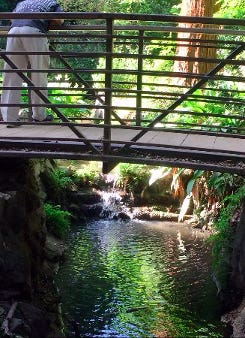
Torah on the Streets of LA
In drought-prone Southern California, even with our thirst-slaking system of canals and reservoirs, our water supply often seems in the hands of a Higher Power. In the first part of this week’s Torah double Torah portion Chukat- Balak, we find out how that holy source responds to a plea for water. In the portion, Israel is in the wilderness and they are without water. In a mood darker than any rain cloud, the community asks Moses: “Why have you brought the Lord’s congregation into this wilderness for us and our beasts to die there?” Looking for some divine intervention, Moses and Aaron fall on their faces and God responds with a miraculous plan: In front of the people, take the rod and “order the rock to yield its water.” However, diverting from the divine plan, Moses strikes the rock twice instead. Water comes out anyway, in miraculous quantities; enough for every person and animal, but Moses is in hot water with the Lord. His striking the rock and not believing that words alone would suffice shows a lack of trust in the Holy One. As a result, God tells Moses that he will not lead the people into the land of Milk and Honey. Though Angelenos have some experience with tar oozing from the ground, we are a tad dry on instances of water from the rock. Yet, there are places like Fern Dell near a southwestern corner of Griffith Park, where we can experience the sounds and wonder of water flowing over stone. The stream is fed by a natural spring, and people have been coming to this fern-filled and sycamore-covered ravine for over one hundred years. In the 20’s, some people thought the waters had curative powers. In the 1930s and 40s, Fern Dell was a popular spot for picnics with Jewish organizations such as Jr. Hadassah, and a Jewish hiking group called Walkers and Talkers. On a recent Sunday, it served as a peaceful oasis in a city of Covid-19 fears; a miracle in itself.
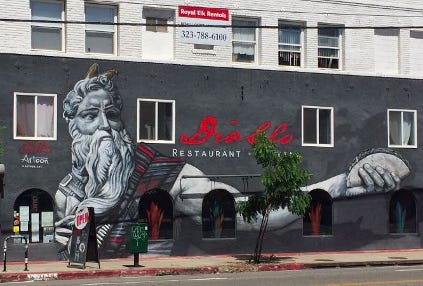
GUIDE FOR THE JEWPLEXED
On the horns of a myth about Jews
Edmon J. Rodman
In this time of heightened cultural sensitivity, as I was driving down Sunset Boulevard to Silver Lake, a mural, playing on a famous artist’s work, poked me in the eye. Painted on the front of a Mexican restaurant, the long mural depicted a standing Michelangelo-esque Moses with a taco in his outstretched hand. Just like the famous early 16th century sculpture, Moses had horns.
Turning the car around to take another look, I parked and got out. At first, I found the mural to be well-executed, and kind of funny. But then I noticed the name of the restaurant, Diablo, devil, painted in red above it. Acting like a poke in the gut, that double-horned word made me wince, piercing my smile.
“I feel an artist’s job is to elicit an emotion out of a person, whether it’s to smile or to cry,” said Artoon, the artist who created the mural, on his website.
Well, then, job well done.
I get it that the artist and restaurant are seemingly using the horned image of Moses, a Jew as devil, in some kind of ironic way of saying: “We’re all past this kind of thinking.” But believe me, many of us are not.
Though we may joke about it (The Klezmatics have an album called “Jews with Horns”) many Jews have had to set the record straight with co-workers, fellow students, acquaintances, even friends, about Jews having horns. During WW II, while in the U.S. Navy, my father was asked where his were. The questioner didn’t like the answer, and a fight ensued.
More recently, one of my sons, while an undergraduate at the University of Wisconsin at Madison, was asked about his horns as well. In that case, the two worked it more peacefully, and even became friends.
The Jew-as-devil thing goes way back; some think to the very statue upon which Artoon, based his mural.
Many art experts believe that the creation of a horned Moses by Michelangelo is the result of a mistranslation of the word “Keren” in Exodus. An English translation of the Latin Vulgate, describing Moses as he comes down Mount Sinai for the Second time with the Ten Commandments, reads, “And when Moses came down from the Mount Sinai, he held the two tablets of the testimony, and he knew not that his face was horned from the conversation of the Lord.” That latter part of same verse translated from Hebrew reads quite differently: “Moses was not aware that the skin of his face was radiant, since he had spoken with Him.”
In other words, those horns should have been rays.
It is this image of a horned Moses, which was portrayed in art of the Middle Ages by both Michelangelo and Donatello that has left a devilish myth that refuses to go away. (Decades ago, when Cedar-Sinai’s copy of Michelangelo’s Moses sculpture arrived, they were aghast to find it was horned, and had them sawed off.)
Though the horns may have been meant to symbolize power, says a website about anti-Semitic stereotypes published by the University of North Carolina at Chapel Hill, “horns naturally became affiliated with evil in the Christian tradition.” The connection to Moses, and then eventually all Jews, with horns “led to an overall stereotype as Jews being affiliated with the devil.”
What harm can some little horns do? Just google “Jews as Devils” sometime and you will find image after image, and book after book attempting to dispel the enduring, hateful, stereotype.
The fact that the mural has been up since at least 2018, in clear view on a heavily trafficked thoroughfare, without receiving public comment, at least that I can find, does not put this issue to rest.
As we hopefully are discovering, Blacks and Latinos in cities across America, have until now, quietly endured public sculpture in their midst that they found hurtful, or hateful. A Moses with horns also generates pain. The image has resulted in discrimination, humiliation, prejudice, and anti-Semitism.
Many Jews may not have understood, the oppressiveness these Civil War and Colonial sculptures represent, and some of us may not be ruffled or riled by a well-painted Jew with horns on a trendy popular restaurant. But if you take a closer look, you will find that the devil is in the details.
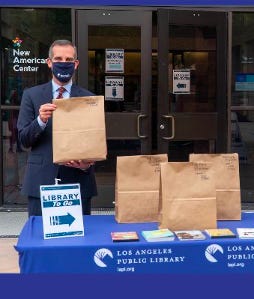
What is Mayor Garcetti reading these days?
Books to go
Through a new program called Library to Go, 18 Los Angeles Public Library locations are now open, by appointment only, for library patrons to collect books on hold and return materials. Holds may be picked up by appointment Monday - Friday, 10 a.m. - 4:30 p.m.
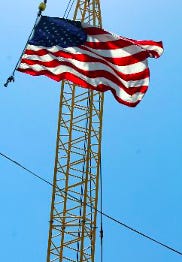
Tunneling into Jewish life at Wilshire and La Brea
At the eastern end of the Miracle Mile, an enormous United Sates flag was waving from a construction crane near the future site of the Wilshire/La Brea station of LA Metro’s Purple Line. Turns out, the flag was flying over a corner with a lot of Jewish history.
In the 1920s and 30s the Ritz Theater was on this corner, and many Jewish groups like the religious school at Temple B’nai B’rith, and the organization called Pioneer Women used it for meetings. A chapter of the B’nai B’rith also met nearby. With so many Jews being drawn to this intersection it was a good location for a Jewish deli. Joseph’s Delicatessen run by Joseph Lacks and Paul Lefkowitz served “strictly kosher Chicago products (Wilno brand), as well as home-made beet borscht, gefilte fish, cheese blintzes and a delicacy called “pitzeh,” (ptcha) jellied calf’s foot.
In 1931, Adolph Sieroty, grandfather of former California State Senator and Assemblyman, Alan Sieroty, announced the opening of one of his family’s Eastern Department Store branches at Wilshire and La Brea.
Also at this intersection, in 1957, over one hundred lay and rabbinic leaders of the Reform Movement had a breakfast meeting at Huddle restaurant.
In 1965, Columbia Savings, founded by Holocaust survivor Abraham Spiegel, opened a very contemporary-styled bank branch (demolished in 2010) on the southeast corner.
Watching the flag, and thinking about the opportunity it represented to Jews traveling to this corner, I wondered how best to remember their endeavors. A display on the walls of the new metro station would be a natural fit.
Seen on the Way/Montana Ave.
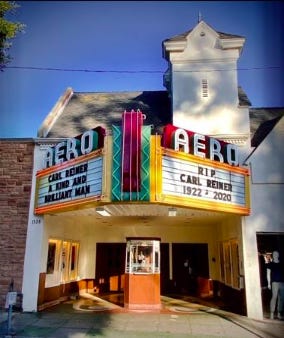




Strong, enlightening and excellent issue.